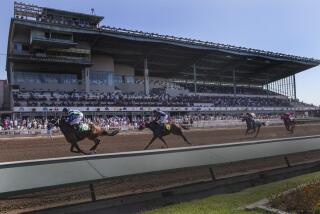HORSES : Equine Patients Get the Massage
- Share via
Joe Kool wasn’t feeling so cool until equine massage therapist Carol Deflavio came along. The palomino had come up severely lame after a trail ride through the hills of Orange Park Acres. When traditional veterinary treatment did not produce results, Joe’s owner consulted Deflavio, a certified equine sports massage therapist from Laguna Niguel.
The 25-year-old horse was in obvious pain, his entire left side stiff and sore. Deflavio evaluated his injuries and began massaging the horse’s muscles from his neck all the way to his flank on both sides. Joe, who initially looked askance at Deflavio, eventually began to relax. An hour and a half later, the four-footed patient was moving like a youngster and clearly feeling less pain.
By then, Deflavio could have used a massage herself. After rubbing the horse’s muscles and leaning her weight into the effort, the “doctor” was tired.
“If the horse relaxes and accepts what you’re trying to do for him, the pain leaves his body and goes into yours,” she said.
It’s a small price to pay for a horse lover like Deflavio, who had to complete a grueling weeklong certification course at an equine sports massage therapy training center in North Carolina. In addition to mastering proper massage techniques, she had to learn equine anatomy and physiology. For one of her final tests, a horse was brought out. Deflavio, while blindfolded, had to name every muscle in the horse and its function. Later, she had to demonstrate her massage techniques on a 17-hand (very tall) horse.
Deflavio sees little distinction between massage therapy for athletes human or equine. “Horses, especially those used for competition, are athletes. If any athlete is pushed in training to perform to his maximum capability, you’re bound to have soreness or injury at some point,” she said.
However, equine massage can also be used as preventive medicine. The Olympic equestrian teams of many nations, including the United States, have used massage therapy since the 1970s as part of their training regimen. Some racehorse trainers incorporate massage into their dailywarm-up routines. Despite the conventional wisdom that a walk-trot routine will prepare a horse for a strenuous workout, Deflavio said that won’t adequately warm up a horse that has tight muscles.
She finds that nervous horses, particularly those in high-level competition, tend to be more prone to muscle tightness or soreness. But other factors can make a horse a candidate for massage therapy, including advancing age or conformation defects.
Some owners consult Deflavio when they don’t know why a horse isn’t quite performing to its potential. A cowboy recently called to grumble that he was considering selling what had been his favorite competition horse because it was tossing its head, refusing to lean into turns and was “just not working right.” The horse didn’t appear lame or sore, but the cowboy decided to try massage therapy as a “last shot” before deciding whether to get rid of the horse.
He’s glad he did. Upon initial examination, Deflavio discovered a deep muscle knot on the left side of the horse’s neck. The day after she treated the horse, the cowboy entered it in a competition and placed in the top 10 of 45 competitors. He asked Deflavio to return the next day and repeat the treatment before the next round of the competition. She did--and the horse was soon back to its competitive best, qualifying for the championship round.
The cowboy called Deflavio with the news. “You saved my horse,” he said. “I’m going to keep him.”
Deflavio’s own horse, Finnigan, benefits from an occasional massage. The chestnut gelding, which she stables in San Juan Capistrano, has carried her to a number of victories in the demanding equine sport of three-day eventing.
Deflavio charges $40 per session for equine massage therapy. She can be reached at (714) 643-0377.
More to Read
Go beyond the scoreboard
Get the latest on L.A.'s teams in the daily Sports Report newsletter.
You may occasionally receive promotional content from the Los Angeles Times.










